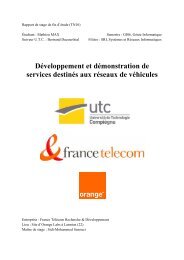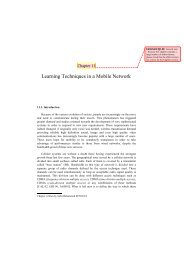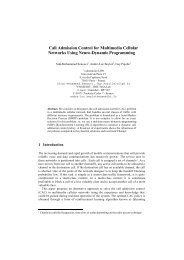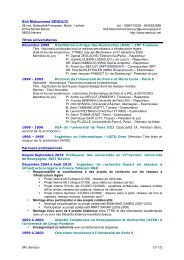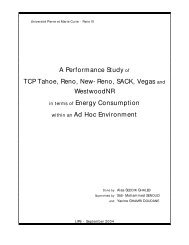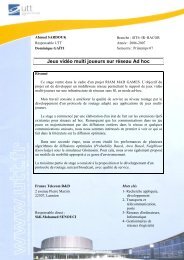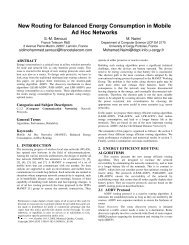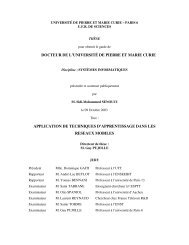Ambience Project ³Find a Meeting´ Video - Sidi Mohammed Senouci
Ambience Project ³Find a Meeting´ Video - Sidi Mohammed Senouci
Ambience Project ³Find a Meeting´ Video - Sidi Mohammed Senouci
You also want an ePaper? Increase the reach of your titles
YUMPU automatically turns print PDFs into web optimized ePapers that Google loves.
O PMQ K@L4MNRCS¢TU§VSW' (*34122+34' 5 1276829'&'+,-+.4' / ) +.:(¢12.4+";¢#C-authentication-services access-XML request processing-XML response sendingIJ £¦ ¦"!$#§%-participants list (+their rights)-conference list-document listI§J=8,-+) 5 +.=7,-+) 5 +.)LJXUH6HUYHU$UFKLWHFWXUH0RELOH5RERWVC#% ¦A¦ABC© ¨?B¢¦¨ C¥"E"#%-XML parsing-dispatch requestamong services-return serviceresponse¦AF ¢ 8© #%G"? ¥ # ©UPDATESEND a MSGFIND A PERSON«unique instanceseveral instancesThe robots [SPIF] have been designed and built atENST’s Computer Science department with standard,low cost hardware components. Their architecture isopen and modular to meet the needs of sensor andactuator customisation. The board offers standardcommunications: Ethernet, 802.11 and Bluetooth. Italso provides a wide range of input output interfaces:USB, I2C, PCMCIA, 115 Kbits IRDA, ISO 7816-2Smartcard, 8 bit audio CODEC, graphical LCDtouchscreen.The battery is controlled by a dedicated circuit thatkeeps the processor aware of its load level. When thebattery’s level reaches a low limit, the robot willcomplete its critical tasks, if any, and move towards arefuelling intelligent docking station. The station emitsa laser beam to guide the robot back.)LJXUH0RELOH5RERW$GKRF1HWZRUNLQJIn the scenario described when the participants moveto coffee area for a coffee break, an ad hoc network isestablished to guarantee an ambient communicationservice between them. Ad-hoc networks are multi-hopwireless networks where all nodes cooperativelymaintain network connectivity. Such networks providemobile users with ubiquitous communication capabilityand information access regardless of location.The main challenge in forming ad-hoc networks is therouting. Routing protocols in such networks must beadaptive to face frequent topology changes becauseof node mobility. Minimizing the number of hops is themost common criteria adopted by the routingprotocols proposed within the IETF MANET workinggroup. However, the number of hops criteria is notnecessarily the most suitable metric to build routingdecisions. Route selection must take into account thecurrent link conditions, to offer a certain quality ofservice (QoS). The basic function of QoS routing is tofind a network path that satisfies some givenconstraints.For the purpose of this demo, we develop a Quality-of-Service (QoS) routing protocol for mobile ad-hocNetworks. This QoS routing protocol aims to enhancethe perceived communication quality within the coffeearea [MBA02]. We perform the proposed QoSenhancedrouting based on the Optimized Link StateRouting (OLSR) protocol [OLSR], introducing a moreappropriate metric than the number of hops. Theproposed QoS routing protocol, called QOLSR,produces better performance comparing with thelegacy OLSR protocol, as depicted in Figure 8.



